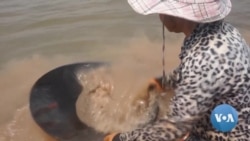The Mekong is one of the world’s great rivers - a 5,000-kilometer waterway which threads from China through Laos, Thailand, Cambodia and Vietnam.
However, dams have subverted the ecosystem, bringing drought in monsoon season and high water when it should be dry. That has forever changed the lives of those dependent on the river's water for food and work in northeastern Thailand.
Panning for flecks of gold on the bank of the Mekong River in northeastern Thailand, Rodjana Thepwong says the waterway has been her playground, food supply and source of income throughout her 64 years.
But it is changing at a speed she can barely believe. She says that when she was younger, the water would be so low in the dry season that she could walk over to the Lao side, a few hundred meters away. Now the water rises in the dry season so she stays on the Thai side of the river and pans for tiny amounts of gold.
Upstream dams - many built by China - have upended the natural cycles of the river, a waterway that subsists 60 million people as it snakes through Laos, Thailand, Cambodia, Myanmar and Vietnam.
The riverbank used to provide farmland to the poorest Mekong villagers. Now water levels rise and fall without warning when the dams are closed to generate electricity, and the land yields little.
Campaigners say fish species have been decimated as the river downstream now lacks vital sediment, sending a shock through the entire ecosystem.
Locals fear a new $2 billion China-backed hydroelectric dam planned for Sanakham on the Mekong in Laos - less than 2 kilometers away - will be the end of the living river in northern Thailand -- that it will lack nutrients and the sediment that provides nutrients for fish.
The dam is currently undergoing a consultation process, but that is widely seen as a formality.
From a rare conservation area on the Thai bank, a few kilometers downstream from the proposed dam, local researcher Apisit Soontrawirat maps the destruction of the river.
He says the Chinese and Lao dams have ruined the ecosystem and dozens of species of fish have vanished due to lack of sediment.
Dam operators say they have taken all precautions to mitigate environmental damage, including creating a “fish ladder” to allow species to migrate during spawning season.
From his riverside view, Apisit says big business - in China, Laos and Thailand - is wringing money from a shared natural resource.
He says villagers are not getting the benefits of the dams. Instead, the gain goes to the big businesses behind the hydropower.
From a small hut, a network of fishermen defends the river from the big hydropower plants, a holdout outsized by the business interests ranged against them.
Chaiwat, one of the fishermen, says locals call the Mekong the River of Life, and all they want is for it to be returned to them, so they can live from its bounty, even if it’s not the same as before.
With fish stocks depleted, many fishermen have left the waterway for work in rubber fields or factories in the city.
For those who eke out a living from the river, another proposed dam in Pak Chom, the first across the Thai stretch of water, would make the people who still eat, live and work along its waters destitute.
Fisherman Sudta Insamran has a simple plea.
It’s time to stop building dams, he says, and return the Mekong River to the people.







